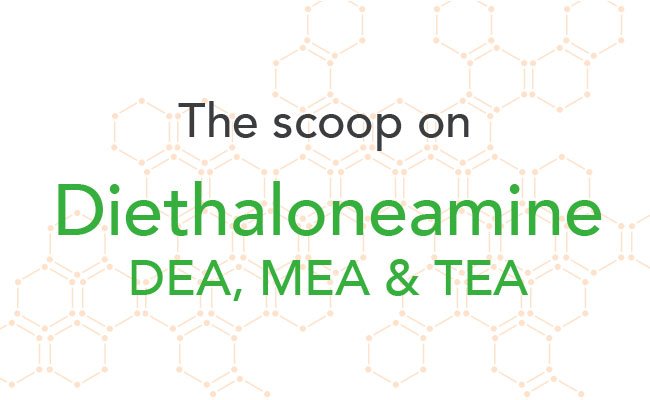What are Ethanolamine Compounds (DEA, MEA or TEA): Chemical Free Living

Toxic Chemical Glossary:
What are Ethanolamine Compounds (DEA, MEA, or TEA): Chemical Free Living
What are ethanolamine compounds (DEA, MEA, or TEA)?
Ethanolamine compounds are used as emulsifying agents, fragrances and pH adjusters [3] [1] in soaps, cosmetics, household cleaning products, and personal care products.
What products are ethanolamine compounds in?
These chemicals are widely used in soaps, shampoos, cosmetics, household cleaners, lotions, shaving creams, pharmaceuticals, sunscreens, and other personal care items [3] [1].
How to tell if a product has ethanolamine compounds
These chemicals may be listed as any of the following: DEA-cetyl phosphate, DEA oleth-3 phosphate, triethanolamine, diethanolamine, cocamide DEA, cocamide MEA, DEA, TEA, lauramide DEA, linoleamide MEA, myristamide DEA, oleamide DEA, TEA-lauryl sulfate, or stearamide MEA [1].
Risks associated with ethanolamine compounds
Diethanolamine is a chemical that’s regarded as toxic enough in the European Union to be banned from personal products and cosmetics [4]. Diethanolamine or DEA has been linked to the following health issues:
- Hormone disruption [2]
- Cancer [4] [2]
- Liver tumors [1]
- Accumulation in the liver & kidney causing organ toxicity [1]
TEA and DEA have been associated with cancer in the liver in female mice [1].
How to avoid ethanolamine compounds:
Always read the product labels on household cleaners, cosmetics, and personal care items and avoid products that contain myristamide DEA, DEA-cetyl phosphate, DEA oleth-3 phosphate, triethanolamine, diethanolamine, cocamide DEA, cocamide MEA, DEA, TEA, lauramide DEA, linoleamide MEA, oleamide DEA, TEA-lauryl sulfate, or stearamide MEA [1]. In cleaning products, where manufacturers aren’t required to list all their ingredients on product labels, choose toxic chemical free alternatives with safe natural ingredients. Also remember that there are no federal criteria dictating standards for what makes something a “natural” cleaner, so avoid cleaners with fragrances, preservatives and dyes.
References:
[1] Campaign for Safe Cosmetics (2016). Ethanolamine compounds (MEA, DEA, TEA and others). Available online: http://www.safecosmetics.org/get-the-facts/chemicals-of-concern/ethanolamine-compounds/ December 8, 2016.
[2] Healthy Child Healthy World (2013). The Toxic Takeover of Baby Nurseries: Chemicals of Concern Found in Almost Every Product and Furnishing. Available online: http://healthychild.org/assets/toxic-takeover-of-baby-nurseries.pdf December 8, 2016.
[3] CDC (2013). Request for information about diethanolamine. Available online: http://www.cdc.gov/niosh/docket/review/docket263/default.html December 8, 2016.
[4] SaferChemicals.org (2015). Is that a toxic chemical in my deodorant? Available online: http://saferchemicals.org/2015/05/26/is-that-a-toxic-chemical-in-my-deodorant/ December 8, 2016.
